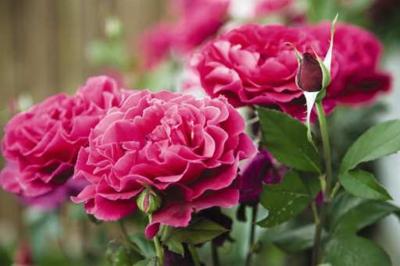“You can complain because roses have thorns, or you can be grateful that thorn bushes have roses.” — Tom Wilson, Plants Are Some of My Favorite People!
A rose is a rose is a rose, until the knockout rose shows its presence with prolific flowers and low maintenance. There are basically six categories of roses — including the hybrid teas, floribunda, grandiflora, climber/rambler, miniatures and the bush or shrub roses. Common selections of shrub roses include the David Austin “English” roses and the Knockout roses (Rosa “RADrazz”) series which were created by rose breeder William Radler. Many landscapers and gardeners select roses from this group because of their prolific blooms throughout the entire growing season, as well as better disease resistance to black spot, one of the main fungal problems of roses.
Knockout roses have stunning flower power and are one of the hottest plants to be marketed in years. It is an awesome landscape shrub rose with either single or double blossoms exhibiting disease tolerance and a long blooming cycle offering a mild, spice tea fragrance. The Knockout rose was first introduced in 2000 and acclaimed a "breakthrough shrub rose" by the All-American Rose Selections because of its exceptional disease resistance and hardiness. Knockout roses stand true to their name and are truly knockouts in curb appeal and aesthetics.
The female parent (the seed parent) was a seedling of the “Carefree Beauty” variety and the male parent (the pollen parent) was a seedling of the “Razzle Dazzle” variety. Gardeners love these colorful shrub roses because they bloom profusely with minimal care throughout the season from spring until frost. Their decorative buds are also a positive attribute.
They are drought tolerant, self-cleaning (don’t have to deadhead them), and resistant to black spot and powdery mildew. Since they require little maintenance, they are ideal for gardeners who enjoy roses but aren't interested in the upkeep required to grow hybrid tea roses. The only limitations of Knockout roses are their lack of a strong fragrance, their short duration as cut flowers, and their susceptibility to rose rosette disease (caused by a virus).
The Knockout family of roses includes Knockout (Rosa “Radrazz”), Double Knockout (Rosa “Radtko”), Pink Knockout (Rosa “Radcon”), Pink Double Knockout (Rosa “Radtkopink”), Rainbow Knockout (Rosa “Radcor”), Blushing Knockout (Rosa “Radyod”), and Sunny Knockout (Rosa “Radsunny”). Also, the Knockout patio tree roses (Rosa “Radrazz” and Rosa “Radsunny”) are available for planting in the ground or in containers. Check out the different colors of Knockout roses. The original color was red and followed by dark pink. The rainbow roses are coral with yellow centers, the blushing roses are a light to shell pink and the sunny roses are yellow. Decide if you want to plant one color or alternate colors in a desirable design pattern.
Grafted and non-grafted plants are available, and both should perform well. The Knockout family of roses can fit into any landscape. Plant them individually among shrubs, annuals and perennials in mixed beds and borders. Also, plant them in large groups to create a colorful hedge or plant them along a foundation to provide a bright border.
Like all roses, Knockout roses need to be planted in microenvironments where they will receive at least six to eight hours of sunlight each day, experience good air movement and a well-drained soil with a pH between 6.0 and 6.5. They generally grow three to five feet tall and equally as wide, so be sure to space them appropriately. After planting, water them regularly until they get established. Also apply a three-inch layer of mulch to help retain moisture in the soil, pulling the mulch back from the stem of the plants. These roses are winter hardy and have good heat and humidity tolerance.
Armed with thorns or prickles, this bushy, compact, and rounded rose offers glossy, dark green foliage which turns to burgundy in the fall. Blooms are fire engine red in cool weather and a cherry red in the summer months. They are drought tolerant and adapted to periodic trims for size control or a once a year cut (to about 12-18 inches above the ground) in early spring (after the last hard frost and as new shoots emerge from the canes) for maximum performance. Do not prune in the fall or winter. It can be grown in the ground or in a container which will require some winter protection.
Water thoroughly around the base of any new plantings and allow it to soak in. Repeat this procedure as necessary for the next couple of weeks to ensure good health. Mulch around the plant to help retain moisture and reduce weeds. Plant the roses about 4-5 feet apart to allow for room to grow and good air circulation. To insure continuous flowering, feed your roses with a fertilizer blended especially for Knockout roses after each bloom cycle (ie. 3 percent N, 4 percent P and 3 percent K with 9 percent Ca, 0.5 percent Mg and 1 percent S). There is no need to remove faded flowers since these roses are self-cleaning.
The main purpose of breeding a Knockout rose was to create a rose plant that is known for its hardiness, a masculine characteristic. Traditionally, roses were known for their qualities of effeminate characteristics of elegance and beauty, adding flare to garden themes. Such American beauties are very fragile and vulnerable to destruction caused by diseases and other harmful elements of nature.
The Knockout rose is facing a serious viral disease called rose rosette. Once infected, a healthy plant starts producing Medusa-like bunches of new bright-red shoots. These shoots bloom, but the flowers are distorted. As rose rosette spreads through the plant, the rose gradually dies a slow death. The virus is primarily spread by tiny eriophyid mites which can blow into landscapes with the wind. As they feed on a rose, they transmit the virus into the rose. Most rose species and their selections are vulnerable to rose rosette.
When planting new roses in the landscape, be sure to leave enough space between plants for each plant to mature without overlapping stems or leaves of neighboring roses. This strategy will help prevent mites from crawling from one plant to the next. Also, remove any wild multiflora roses that exist within 100 yards of the landscape since they are very susceptible to this virus and serve to promote the problem. Unfortunately, since infected plants are not curable it is suggested to remove any diseased plants from the landscape.
Being disease resistant, winter hardy and heat tolerant generally describes a bermudagrass, winter cherry and desert cactus combined. But indeed, Knockout roses inherit these masculine qualities to the degree that they are actually living up to the title of being the newest and toughest American beauties of their perennial kind (until the viral attack). Enjoy your Knockout roses this season and each season that follows with very little effort.
As you commit to the effort and cost of spring purchasing and landscaping, please also commit to providing the necessary care to keep them healthy and attractive. Continue to think in terms of native and sustainable plants in the landscape since these will be more environmentally-friendly and easier to maintain. As the weather permits, get outside and enjoy your late winter/early spring gardening! And, as always, remember to feed and water the birds in your neighborhood and continue to protect your pets from cold weather.
“Humble yourselves, therefore, under God's mighty hand, that he may lift you up in due time. Cast all your anxiety on him because he cares for you.” — 1 Peter 5: 6-7.
Dr. Eddie Seagle is a Sustainability Associate, Golf Environment Organization (Scotland), Agronomist and Horticulturalist, CSI: Seagle (Consulting Services International), Professor Emeritus and Honorary Alumnus, Abraham Baldwin Agricultural College, and Associate Editor of The Golf Course, International Journal of Golf Science. Direct inquiries to eddie@csiseagle.com.

















Commented
Sorry, there are no recent results for popular commented articles.